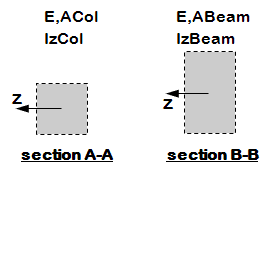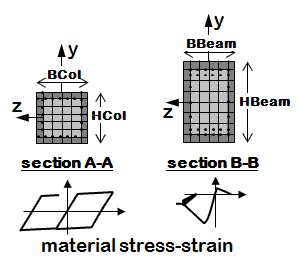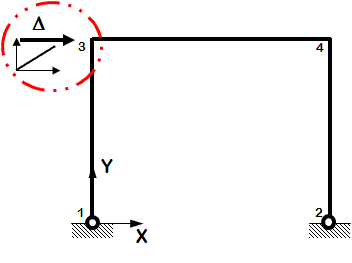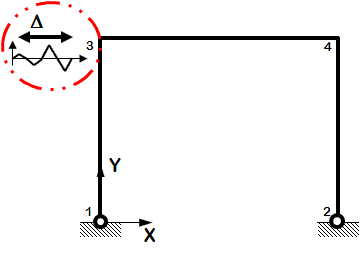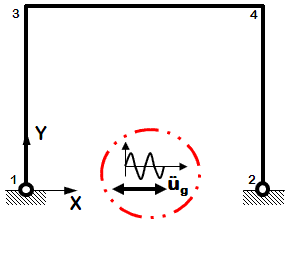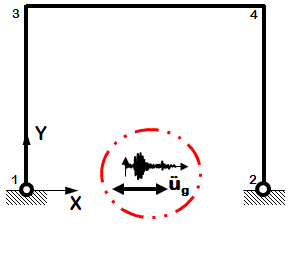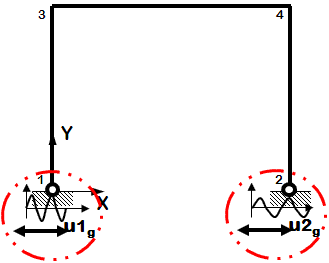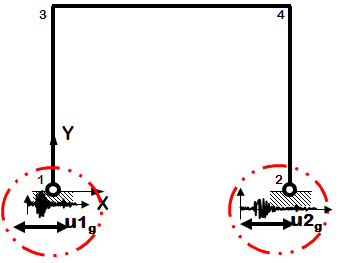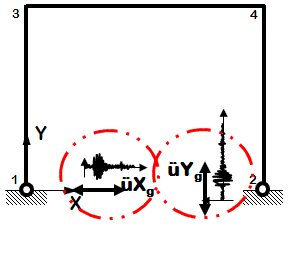OpenSees Example 4. Portal Frame: Difference between revisions
Jump to navigation
Jump to search
No edit summary |
No edit summary |
||
| (17 intermediate revisions by 2 users not shown) | |||
| Line 1: | Line 1: | ||
==Introduction== | ==Introduction== | ||
This is a great example! | This is a great example! | ||
| Line 19: | Line 18: | ||
{| style="margin:0; background:none;" | {| style="margin:0; background:none;" | ||
<!-- Column 1 --> | <!-- Column 1 --> | ||
| style="margin:0; width:25%; border: | | style="margin:0; width:25%; border:3px solid #ccc; background:#white; vertical-align:top; " | | ||
{| style="width:100%; vertical-align:top;background:#white;" | {| style="width:100%; vertical-align:top;background:#white;" | ||
<h4>Elastic Element</h4> | <h4>Elastic Element</h4> | ||
| Line 37: | Line 36: | ||
|} | |} | ||
<!-- Column 2 --> | <!-- Column 2 --> | ||
| style="margin:0; width:25%; border: | | style="margin:0; width:25%; border:3px solid #ccc; background:#white; vertical-align:top; " | | ||
{| style="width:100%; vertical-align:top;background:#white;" | {| style="width:100%; vertical-align:top;background:#white;" | ||
<h4>Distributed Plasticity Element, Uniaxial Section</h4> | <h4>Distributed Plasticity Element, Uniaxial Section</h4> | ||
| Line 56: | Line 55: | ||
|} | |} | ||
<!-- Column 3 --> | <!-- Column 3 --> | ||
| style="margin:0; width:25%; border: | | style="margin:0; width:25%; border:3px solid #ccc; background:#white; vertical-align:top; " | | ||
{| style="width:100%; vertical-align:top;background:#white;" | {| style="width:100%; vertical-align:top;background:#white;" | ||
<h4>Distributed Plasticity Element, Fiber Section</h4> | <h4>Distributed Plasticity Element, Fiber Section</h4> | ||
| Line 65: | Line 64: | ||
---- | ---- | ||
<strong>Files</strong> | <strong>Files</strong> | ||
*[[Media:Ex4.Portal2D.build.InelasticFiberSection.tcl| | *[[Media:Ex4.Portal2D.build.InelasticFiberSection.tcl|Ex4.Portal2D.build.InelasticFiberSection.tcl]] | ||
*[[Media:LibUnits.tcl|LibUnits.tcl]] | *[[Media:LibUnits.tcl|LibUnits.tcl]] | ||
---- | ---- | ||
| Line 86: | Line 85: | ||
{| style="margin:0; background:none;" | {| style="margin:0; background:none;" | ||
<!-- Column 1 --> | <!-- Column 1 --> | ||
| style="margin:0; width:25%; border: | | style="margin:0; width:25%; border:3px solid #ccc; background:#white; vertical-align:top; " | | ||
<h4>Static</h4> | <h4>Static</h4> | ||
{| style="width:100%; border:1px solid # | {| style="width:100%; border:1px solid #ddcef2; vertical-align:top;background:#white;" | ||
|- | |- | ||
| style="color:#000;" | <div> | | style="color:#000;" | <div> | ||
<h5>Static Pushover</h5> | |||
[[File:Example4_Push.GIF|link=OpenSees Example 4. Portal Frame]] | [[File:Example4_Push.GIF|link=OpenSees Example 4. Portal Frame]] | ||
---- | ---- | ||
| Line 102: | Line 101: | ||
</div> | </div> | ||
|} | |} | ||
---- | ---- | ||
{| style="width:100%; border:1px solid #ddcef2; vertical-align:top;background:#white;" | |||
|- | |- | ||
| style="color:#000;" | <div> | | style="color:#000;" | <div> | ||
<h5>Static Reversed Cyclic</h5> | |||
[[File:Example4_Cyclic.GIF|link=OpenSees Example 4. Portal Frame]] | [[File:Example4_Cyclic.GIF|link=OpenSees Example 4. Portal Frame]] | ||
---- | ---- | ||
| Line 121: | Line 120: | ||
<!-- Column 2 --> | <!-- Column 2 --> | ||
| style="margin:0; width:25%; border: | | style="margin:0; width:25%; border:3px solid #ccc; background:#white; vertical-align:top; " | | ||
<h4>Dynamic EQ Ground Motion</h4> | <h4>Dynamic EQ Ground Motion</h4> | ||
{| style="width:100%; border:1px solid #ddcef2; vertical-align:top;background:#white;" | |||
|- | |||
| style="color:#000;" | <div> | |||
<h5>Dynamic Uniform Sine-Wave Ground Motion</h5> | |||
[[File:Example4_UniformSine.GIF|link=OpenSees Example 4. Portal Frame]] | |||
---- | |||
<strong>Files</strong> | |||
*[[Media:Ex4.Portal2D.analyze.Dynamic.sine.Uniform.tcl|Ex4.Portal2D.analyze.Dynamic.sine.Uniform.tcl]] | |||
*[[Media:LibAnalysisDynamicParameters.tcl|LibAnalysisDynamicParameters.tcl]] | |||
---- | |||
<strong>Notes</strong> | |||
*Sine-wave acceleration input | |||
*Same acceleration input at all nodes restrained in specified direction | |||
</div> | |||
|} | |||
---- | ---- | ||
{| style="width:100%; border:1px solid #ddcef2; vertical-align:top;background:#white;" | |||
|- | |- | ||
| style="color:#000;" | <div> | | style="color:#000;" | <div> | ||
[[File: | <h5>Dynamic Uniform Earthquake Ground Motion (typical)</h5> | ||
[[File:Example4_UniformEQ.GIF|link=OpenSees Example 4. Portal Frame]] | |||
---- | ---- | ||
<strong>Files</strong> | <strong>Files</strong> | ||
*[[Media: | *[[Media:Ex4.Portal2D.analyze.Dynamic.EQ.Uniform.tcl|Ex4.Portal2D.analyze.Dynamic.EQ.Uniform.tcl]] | ||
*[[Media: | *[[Media:LibAnalysisDynamicParameters.tcl|LibAnalysisDynamicParameters.tcl]] | ||
*[[Media:ReadSMDFile.tcl|ReadSMDFile.tcl]] | |||
*[[Media:H-E12140.zip|H-E12140.AT2]] | |||
---- | ---- | ||
<strong>Notes</strong> | <strong>Notes</strong> | ||
*Earthquake (from file) acceleration input | *Earthquake (from file) acceleration input | ||
*Same acceleration input at all nodes restrained in specified direction | *Same acceleration input at all nodes restrained in specified direction | ||
</div> | </div> | ||
|} | |} | ||
---- | |||
{| style="width:100%; border:1px solid #ddcef2; vertical-align:top;background:#white;" | |||
|- | |||
| style="color:#000;" | <div> | |||
<h5>Dynamic Multiple-Support Sine-Wave Ground Motion</h5> | |||
[[File:Example4_MultiSupportSine.GIF|link=OpenSees Example 4. Portal Frame]] | |||
---- | |||
<strong>Files</strong> | |||
*[[Media:Ex4.Portal2D.analyze.Dynamic.sine.multipleSupport.tcl|Ex4.Portal2D.analyze.Dynamic.sine.multipleSupport.tcl]] (this file may need to be corrected for displacement input) | |||
*[[Media:LibAnalysisDynamicParameters.tcl|LibAnalysisDynamicParameters.tcl]] | |||
---- | |||
<strong>Notes</strong> | |||
*Sine-wave displacement input | |||
*Different displacements are specified at particular nodes in specified directions | |||
</div> | |||
|} | |||
---- | |||
{| style="width:100%; border:1px solid #ddcef2; vertical-align:top;background:#white;" | |||
|- | |||
| style="color:#000;" | <div> | |||
<h5>Dynamic Multiple-Support Earthquake Ground Motion</h5> | |||
[[File:Example4_MultiSupportEQ.GIF|link=OpenSees Example 4. Portal Frame]] | |||
---- | |||
<strong>Files</strong> | |||
*[[Media:Ex4.Portal2D.analyze.Dynamic.EQ.multipleSupport.tcl|Ex4.Portal2D.analyze.Dynamic.EQ.multipleSupport.tcl]] (this file needs to be corrected for displacement input) | |||
*[[Media:LibAnalysisDynamicParameters.tcl|LibAnalysisDynamicParameters.tcl]] | |||
*[[Media:ReadSMDFile.tcl|ReadSMDFile.tcl]] | |||
*[[Media:H-E12140D.zip|H-E12140.DT2]] (Displacement recording) | |||
---- | |||
<strong>Notes</strong> | |||
*Earthquake (from file) displacement input | |||
*Different displacements are specified at particular nodes in specified directions | |||
</div> | |||
|} | |||
---- | |||
{| style="width:100%; border:1px solid #ddcef2; vertical-align:top;background:#white;" | |||
|- | |||
| style="color:#000;" | <div> | |||
<h5>Dynamic Bidirectional Earthquake Ground Motion (typical)</h5> | |||
[[File:Example4_BidirectEQ.GIF|link=OpenSees Example 4. Portal Frame]] | |||
---- | |||
<strong>Files</strong> | |||
*[[Media:Ex4.Portal2D.analyze.Dynamic.EQ.bidirect.tcl|Ex4.Portal2D.analyze.Dynamic.EQ.bidirect.tcl]] | |||
*[[Media:LibAnalysisDynamicParameters.tcl|LibAnalysisDynamicParameters.tcl]] | |||
*[[Media:ReadSMDFile.tcl|ReadSMDFile.tcl]] (need to modify ReadSMDFile.tcl for displacement data) | |||
*[[Media:H-E12140.zip|H-E12140.AT2]] | |||
*[[Media:H-E01140.zip|H-E01140.AT2]] (acceleration recording in perpendicular direction) | |||
---- | |||
<strong>Notes</strong> | |||
*Earthquake (from file) acceleration input | |||
*Different ground motion in two directions | |||
*Same acceleration input at all nodes restrained in specified direction | |||
</div> | |||
|} | |||
|} | |} | ||
==Run== | ==Run== | ||
The | The model and analysis combinations for this example are numerous. The following are an small subset, for demonstration purposes: | ||
* To run Elastic Mode, Static Pushover Analysis: | * To run Elastic Mode, Static Pushover Analysis: | ||
| Line 148: | Line 219: | ||
puts " -------------Elastic Model -------------" | puts " -------------Elastic Model -------------" | ||
puts " -------------Static Pushover Analysis -------------" | puts " -------------Static Pushover Analysis -------------" | ||
source | source Ex4.Portal2D.build.ElasticElement.tcl | ||
source | source Ex4.Portal2D.analyze.Static.Push.tcl | ||
</source></blockquote> | </source></blockquote> | ||
| Line 172: | Line 227: | ||
puts " -------------Uniaxial Inelastic Section, Nonlinear Model -------------" | puts " -------------Uniaxial Inelastic Section, Nonlinear Model -------------" | ||
puts " -------------Uniform Earthquake Excitation -------------" | puts " -------------Uniform Earthquake Excitation -------------" | ||
source | source Ex4.Portal2D.build.InelasticSection.tcl | ||
source | source Ex4.Portal2D.analyze.Dynamic.EQ.Uniform.tcl | ||
</source></blockquote> | </source></blockquote> | ||
* To run Uniaxial Inelastic Material, Fiber Section, Nonlinear | * To run Uniaxial Inelastic Material, Fiber Section, Nonlinear Model, Dynamic Bidirectional Earthquake Ground Motion | ||
<blockquote><source lang="Tcl"> | <blockquote><source lang="Tcl"> | ||
puts " -------------Uniaxial Inelastic Material, Fiber Section, Nonlinear Model -------------" | puts " -------------Uniaxial Inelastic Material, Fiber Section, Nonlinear Model -------------" | ||
puts " ------------- | puts " -------------Dynamic Bidirectional Earthquake Ground Motion -------------" | ||
source | source Ex4.Portal2D.build.InelasticFiberSection.tcl | ||
source | source Ex4.Portal2D.analyze.Dynamic.EQ.bidirect.tcl | ||
</source></blockquote> | </source></blockquote> | ||
==Notes== | ==Notes== | ||
---- | ---- | ||
Return to [[OpenSees Examples Manual]] | Return to [[OpenSees Examples Manual -- Structural Models & Analyses]] | ||
Return to [[OpenSees User]] | Return to [[OpenSees User]] | ||
Latest revision as of 23:19, 19 November 2010
Introduction
This is a great example! To all the demonstrations that Example 3 has done, Example 4 adds the use of previously-defined Tcl procedures (a procedure is a Tcl command that is created by the proc command) or scripts. This example also introduces new kinds of static and dynamic analyses.
Input
Model Building
The following tasks are performed when building the model
- define units
- define model
- define recorders for output
- define & apply gravity
Elastic Element
|
Distributed Plasticity Element, Uniaxial Section
|
Distributed Plasticity Element, Fiber Section
|
Lateral-Load Analysis
The following tasks are performed in the analysis
- define lateral-load parameters
- analyze
Static
|
Dynamic EQ Ground Motion
|
Run
The model and analysis combinations for this example are numerous. The following are an small subset, for demonstration purposes:
- To run Elastic Mode, Static Pushover Analysis:
puts " -------------Elastic Model -------------" puts " -------------Static Pushover Analysis -------------" source Ex4.Portal2D.build.ElasticElement.tcl source Ex4.Portal2D.analyze.Static.Push.tcl
- To run Uniaxial Inelastic Section, Nonlinear Model, Uniform Earthquake Excitation
puts " -------------Uniaxial Inelastic Section, Nonlinear Model -------------" puts " -------------Uniform Earthquake Excitation -------------" source Ex4.Portal2D.build.InelasticSection.tcl source Ex4.Portal2D.analyze.Dynamic.EQ.Uniform.tcl
- To run Uniaxial Inelastic Material, Fiber Section, Nonlinear Model, Dynamic Bidirectional Earthquake Ground Motion
puts " -------------Uniaxial Inelastic Material, Fiber Section, Nonlinear Model -------------" puts " -------------Dynamic Bidirectional Earthquake Ground Motion -------------" source Ex4.Portal2D.build.InelasticFiberSection.tcl source Ex4.Portal2D.analyze.Dynamic.EQ.bidirect.tcl
Notes
Return to OpenSees Examples Manual -- Structural Models & Analyses
Return to OpenSees User
